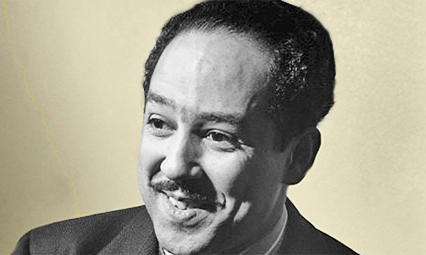
Langston Hughes and Carl Van Vechten met at a party in Harlem in November of 1924. Hughes, just 22 at the time, soon returned to his mother’s home in Washington, DC, but the two did not lose contact. In 1925, Van Vechten sent his first letter to Hughes, sparking a correspondence that would continue until Van Vechten’s death forty years later. In some ways, they were irreconcilably different: Van Vechten did not acknowledge the political possibilities of art as much as Hughes wanted him to, and would become a symbol for the extensive appropriation of black culture that took place in wealthy, white spaces during the Harlem Renaissance. Yet their extreme differences and arguments allowed each man to refine his own ideas on politics and literature. Hughes, twenty years Van Vechten’s junior, was especially influenced, and his first book of poetry, The Weary Blues, was published with help and encouragement from Van Vechten.
In this letter, Hughes documents his interactions with sculptor Richmond Barthé, singer Ethel Waters, and other black artists visiting his friend Noel Sullivan in California. Sullivan, who admired Hughes’ work, had given Hughes full access to the estate in California to write his first short story collection in 1934.
Dear Carlo,
Thanks for your delightfully long letter and all the nice compliments and advice. I agree with you about the second part of The Big Sea. Only I don’t want it to get so weighty that it weighs me down, too.
Barthé left Los Angeles Thursday for Chicago. We enjoyed his visit greatly here. But I didn’t report it in more detail because nobody got cut, and it was just a pleasant quiet time, with some dinner parties, and teas, and cocktails. And Ethel Waters came by one Sunday morning for breakfast with Archie and a car full and Noel took them all to call on Mrs. Blanchard.
It was too bad Eulah and I didn’t get around to having our colored party while Barthé was here. (Eulah Pharr is Noel’s housekeeper, and a very charming person who’s been with him for twelve years or more.) But we had it Thursday, cocktails 3–6, except that it lasted from 3 to 3 in the morning—and nobody made a move to go home before midnight, and then didn’t go. The joint jumped. We had about 5o. And played plenty Lil Green. Everybody was dressed down, and most proper in a gay manner, and nobody got too high or anything, except one girl got mad when she heard her soldier boy intended to take another girl home, so she simply pulled all the wires out his car so it wouldn’t budge—which left him and six other members of Uncle Sam’s citizen army stranded out here in the country, and they had to be taken back to Fort Ord in our station wagon just in time to hear “reverie” blow in the morning.
Your paragraph on the art illustration was most interesting. And I am sure the Kauffer drawings are charming. But still, if they come out with NO hair on their heads—after all the millions that have been spent with Madame Walker and Mr. Murray—my Negro public—whom I respect and like—will not be appreciative. I wrote as much to Blanche when I first saw the samples. Harlem just isn’t nappy-headed any more—except for the first ten minutes after the hair is washed. Following that the sheen equals Valentino’s and the page boy bobs are as long as Lana Turner’s. And colored folks don’t want no stuff out of an illustrator on that score. Even Lil Green has finger waves. And if some of the ladies in SHAKESPEARE IN HARLEM don’t have them, too, I will catch hell—in spite of whatever “strictly personal illumination emanates from the painter.” Do you get me?
I’m sure Henrietta Bruce Sharon is white. But since I couldn’t swear it, I’ve asked Arna to let you know. (But she draws heads and feet as if she were.)
Duke’s I GOT IT BAD is good. But unfortunately the words aren’t mine. They’re by Paul Webster, the white chap who wrote most of the show.
No, Mamie Smith didn’t get her throat cut. She just lost her contract. Why, I will tell you when I see you. (Leaving space at the bottom of this here letter for annotation.)
I am now on my way to hear Lotte Lehman sing.
Ere I lay me down in questa tomba obscura I shall try to find all your letters for Yale, but they are in so many various files, boxes, suitcases, and trunks stored from here to yonder that I shall start here to finding recent ones tomorrow.
To whom are you giving your Mary Bell’s?
The blues seems to be coming back in a big way. Every club out here now has a blues singer as part of the floor show. And Joe Turner was the hit of the recent Duke show, pulling it out of polite prettiness.
Did I tell you I did a libretto of THE ST. LOUIS BLUES for Katherine Dunham, a danceable story woven around the song? Hope she uses it. But she rather thinks she ought to do Latin American things—Cuba, Brazil, etc. Easier to sell to concert managers and Hollywood.
So,
Sincerely,
Langston
November 8, 1941
From Remember Me to Harlem: The Letters of Langston Hughes and Carl Van Vechten, 1925-1962. Edited by Emily Bernard. New York: Alfred A. Knopf, 2001. pp. 198-9.
FURTHER READING
One of Hughes’ first articles about the interaction between politics and art, The Negro Artist and the Racial Mountain, is available here: http://www.poetryfoundation.org/learning/essay/237858.
For one example of Hughes’ lasting impact on New York City, see this 1994 New York Times article on a piece of his poetry displayed in the subway as part of the MTA’s Poetry in Motion series: http://www.nytimes.com/1994/03/02/nyregion/langston-hughes-on-the-irt-a-poem-arouses-many-feelings.html.


